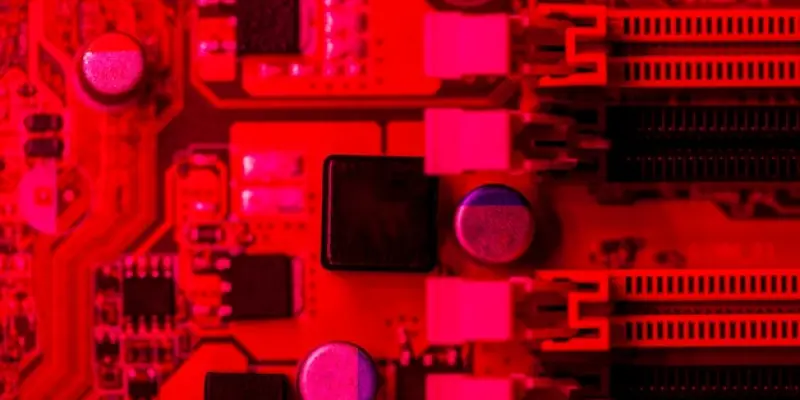In a move that has stirred excitement among technology enthusiasts, AMD is poised to release its much-anticipated Radeon RX 9070 GRE 12 GB graphics card. The card is generating buzz as it becomes available for pre-order in China, with a launch set for May 8th. This product marks an expansion of AMD’s RDNA 4 lineup and presents an intriguing blend of affordability and high performance. The Radeon RX 9070 GRE is built using TSMC’s 4nm process, boasting 53.9 billion transistors, and is considered a direct upgrade from its predecessor, the RX 7900 GRE. The ASUS Radeon RX 9070 GRE ATS OC model underscores AMD’s strategic focus on efficiency and power, employing a substantial triple-fan, dual-slot cooler design that suggests impressive thermal regulation.
Understanding the Radeon RX 9070 GRE’s Technical Merits
Analyzing Core and Memory Specifications
The RX 9070 GRE stands out with its sophisticated core and memory features, embodying AMD’s commitment to enhancing user experience at a competitive price point. With 3,072 cores capable of reaching clock speeds up to 2,790 MHz, this graphics card maintains efficient operation that caters to demanding applications and gamers. It comes with 12 GB of VRAM and employs a 192-bit memory bus, granting it a bandwidth of 432 GB/s. These specifications highlight its potential to deliver smooth and stable performance, particularly in graphically intense scenarios. Strategically priced around 4,476 RMB, the RX 9070 GRE aligns closely with an estimated $450 in US pricing, maintaining consistency despite market fluctuations. Its design necessitates dual 8-pin power connectors and runs at a Total Board Power (TBP) of 220W, recommending a 750W power supply unit to ensure optimal power delivery. This configuration not only promises ample support for most current gaming titles but also suggests longevity with potential future-proofing for upcoming software.
Performance Advancements and Market Position
The AMD Radeon RX 9070 GRE represents a notable improvement over its predecessor in terms of raw performance metrics. It is reported to be up to 6% faster than the RX 7900 GRE at a 1440p resolution, presenting a tangible upgrade for users seeking enhanced graphical fidelity and frame rates. This performance boost is especially significant within competitive gaming environments, where every frame can influence the gameplay experience.
This new entrant to the market signifies AMD’s ongoing effort to strike a balance between elevated performance and accessible pricing, thereby appealing to a wide audience from gamers to professional users. The company’s embrace of cost-effective strategies paired with robust performance offerings signifies their dedication to maintaining relevancy and competitive pressure within the GPU market.
Strategic Launch and Broader Implications
Market Timing and Consumer Expectations
AMD’s decision to advance the launch of the Radeon RX 9070 GRE to May showcases its agility in responding to consumer demand and market dynamics. By moving the release from a speculated Q4 timeframe, AMD signals a strategic push to capture market share promptly. This move is crucial in avoiding potential bottlenecks and ensuring that the supply aligns with the anticipated demand spike, especially given the card’s appealing price-performance ratio.
The clever timing also places AMD in a competitive stance against other major players in the industry, allowing them to maximize their market presence during pivotal buying seasons. The release is not just a showcase of technology but also a demonstration of AMD’s adeptness at navigating the complex landscape of global supply chains and consumer electronics markets.
Long-term Impact on AMD’s Product Line
The introduction of the Radeon RX 9070 GRE is more than a product launch; it’s a strategic maneuver poised to influence AMD’s positioning for future developments. As part of the RDNA 4 lineup, this graphics card reinforces AMD’s ongoing innovation, emphasizing performance while navigating cost constraints effectively. Such innovations continually keep AMD at the forefront of the graphics industry, leveraging cutting-edge technology and meticulous design philosophies.
This release may well serve as a benchmark for future entries in the series, potentially shaping the trajectory of subsequent RDNA architecture iterations. AMD’s ability to iterate on product design while delivering consumer-centric solutions hints at its sustained commitment to advancement in high-performance graphics solutions. The trajectory the RX 9070 GRE sets could redefine consumer expectations and solidify AMD’s standing as a formidable player in the graphics domain well into the future.
Looking Ahead with the Radeon RX 9070 GRE
AMD has ignited enthusiasm among tech aficionados with the impending release of its eagerly awaited Radeon RX 9070 GRE 12 GB graphics card. This innovative product is attracting attention as it is now open for pre-order in China, ahead of its official launch on May 8th. This graphics card represents an exciting addition to AMD’s RDNA 4 series, offering a compelling mix of cost-effectiveness and powerful performance. Built using TSMC’s cutting-edge 4nm process, the RX 9070 GRE features a groundbreaking 53.9 billion transistors, making it a significant upgrade from the previous RX 7900 GRE model. The ASUS Radeon RX 9070 GRE ATS OC version highlights AMD’s committed focus on efficiency and power. Its robust triple-fan, dual-slot cooling system indicates superior thermal management, essential for maintaining optimal performance under demanding conditions. This development epitomizes AMD’s forward-thinking approach in delivering advanced technology solutions, catering to the needs of consumers seeking high performance and value.

